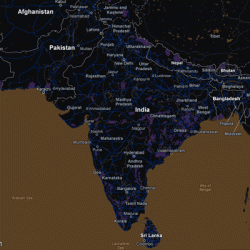This is not a repeat from yesterday. It is worse.
For the second day in a row, power consumption in India vastly exceeded available supply, due in part to high temperatures. The result: grid failure that first struck the northern part of the country — which had the same issue yesterday — then, the eastern. Reuters suggests that the outage affected 670 million people — 9.5 percent of all people on Earth. For nearly four hours, power and transportation systems in the nation’s capital were at a standstill, forcing hospitals and “VIP zones” to rely on generator backups. From the Pittsburgh Post-Gazette:
Hundreds of trains stalled across the country and traffic lights went out, causing widespread traffic jams in New Delhi. Electric crematoria stopped operating, some with bodies half burnt, power officials said. Emergency workers rushed generators to coal mines to rescue miners trapped underground.
At least 46 of the 200 trapped miners have since been rescued.

That coal miners were trapped is not without irony. The root of India’s electricity problem, exposed by surging demand in high temperatures, is that a wobbly infrastructure is combined with too little generation. A business trade group puts the blame for generation issues specifically on “the nonavailability of coal.” As we noted last week, the quality of India’s domestic coal is largely too poor for recent-generation coal plants.
The Times’ Andy Revkin has a good round-up of deeper explanations for the power failures, further explaining the link between India’s power problems and its coal problems. He cites the Wall Street Journal, which blames environmental regulations:
More than half of India’s power-generation capacity of 205 gigawatts is coal-based, and Coal India Ltd., the world’s biggest coal producer, is unable to produce enough owing to delays in getting environmental clearances for mining. Meanwhile, government giveaways in the form of free electricity to farmers and a reluctance among politicians to raise power tariffs to sufficiently cover costs have drained cash reserves from the largely state-run electricity-distribution companies, leaving them with mounting debt and hampered ability to purchase power.
But again, it’s not clear that mining more coal would solve the country’s problems. If generation facilities can’t use the coal, there’s not much point in sending more people down to retrieve it.
For more on the power outage (which is now largely resolved): The BBC has a good gallery of images. The Times of India is running a liveblog.




